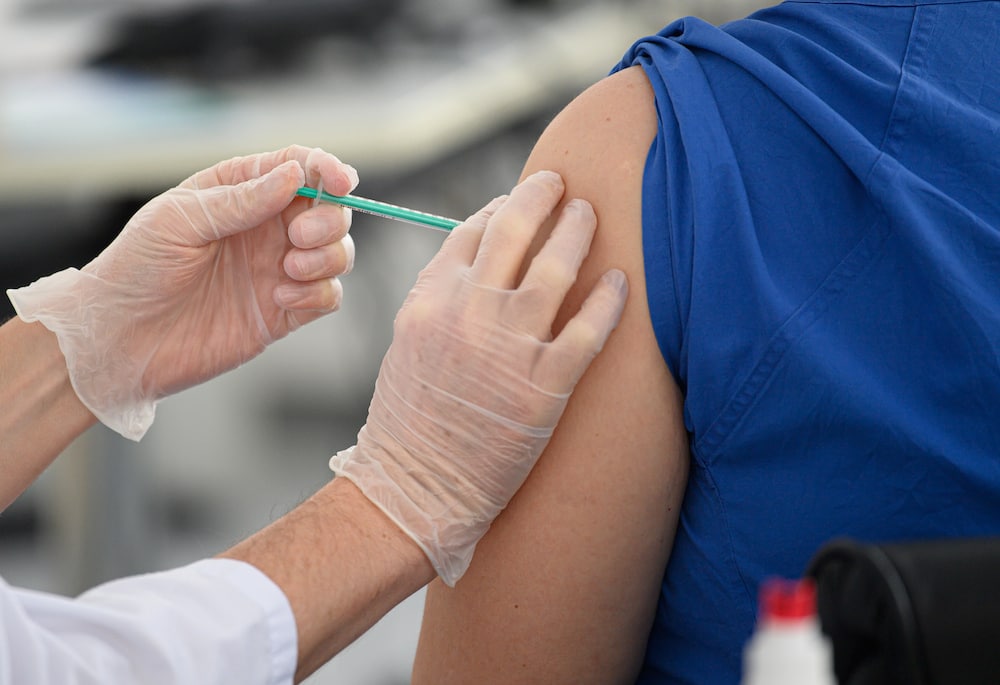The gap between the first and second AstraZeneca jabs has been shortened in a bid to get more Canberrans fully vaccinated as the ACT prepares for its “biggest week yet” in the COVID-19 vaccination rollout.
Over the coming week, the ACT has more than 24,000 Pfizer bookings between the AIS and Canberra Airport mass vaccination sites.
In that time, the ACT Government hopes to get the first dose rate for Canberrans aged 16 and over to 75 per cent, after clocking the 70 per cent mark over the weekend, 4-5 September.
They also want to hit 50 per cent fully vaccinated.
It comes as the two-week priority window opens for year 12 students to get a Pfizer jab so they can sit their exams in person.
This collectively will mark the biggest week of the Territory’s jab rollout to date.
“We’ll build on this in the weeks to come,” said ACT Chief Minister Andrew Barr.
Following Australian Technical Advisory Group on Immunisation (ATAGI) advice, the period of time between doses for the AstraZeneca vaccine has been revised.
People are now able to get their second AZ jab four to eight weeks after their first.
The timeframe has been shortened due to the Delta outbreak; ATAGI otherwise advises a 12-week interval period between jabs in non-outbreak circumstances.
People who hold a second-dose AstraZeneca booking with their GP or pharmacist are advised to contact them to bring their appointment forward.
Mr Barr said the move helps the ACT progress the vaccine schedule more quickly than they otherwise would.
“Everyone who does that obviously gets their full vaccination weeks ahead of when they otherwise would have,” he said.
The Chief Minister noted with the Moderna COVID-19 vaccine coming online nationally later this month, the combination of the three vaccines will allow the total vaccination program to be completed more quickly.
Australia has an advance purchase agreement with Moderna to secure 25 million doses of their vaccine – 10 million this year and 15 million of booster vaccines in 2022, with the first doses due to arrive late September.
Clinical trial research on the AstraZeneca vaccine has indicated optimal protection against infection is provided with a three-month gap between shots.
Despite this, ACT Deputy Chief Health Officer, Dr Vanessa Johnston, said one dose or a reduced gap between two doses still provides “excellent protection against severe disease and hospitalisation”.
“Which is really the main game we’re trying to avoid,” she said.
“What we’re saying is get that protection against severe disease on board early and do it now.”
Currently, ATAGI recommends the Pfizer vaccine is preferred in adults aged under 60 due to the increased risk of thrombosis with thrombocytopenia following AstraZeneca vaccine in those under 60 years.
According to the Therapeutic Goods Administration’s 2 September COVID-19 vaccine weekly safety report, nine deaths have been linked to the AstraZeneca jab from 495 reported deaths that have been received and reviewed by the agency.
Despite this, the report said, “the protective benefits of vaccination against COVID-19 far outweigh the potential risks of vaccination”.
mRNA-based booster shot for ‘everyone’ next year

With the supply already arranged by the Commonwealth Government, mRNA-based booster shots coming down the line will be for everyone regardless of their dosing schedule or the initial vaccine they received.
“There has been some discussion by health officials in regard to those who have had an AZ jab getting an mRNA booster,” Mr Barr said.
The AstraZeneca jab is a viral vector vaccine, while Pfizer and Moderna are both mRNA-based.
According to the Australian Government’s Department of Health, vector vaccines use a weakened animal virus deemed harmless that contains the genetic code for a protein unique to the coronavirus, usually the spike protein.
Messenger ribonucleic acid (mRNA) vaccines use a genetic code called RNA to spark the production of the coronavirus’ specific spike protein.
The Chief Minister said it will be a “rolling program” throughout 2022, with the exact details to be communicated to the nation in due course.
Get all the latest Canberra news, sport, entertainment, lifestyle, competitions and more delivered straight to your inbox with the Canberra Daily Daily Newsletter. Sign up here.



